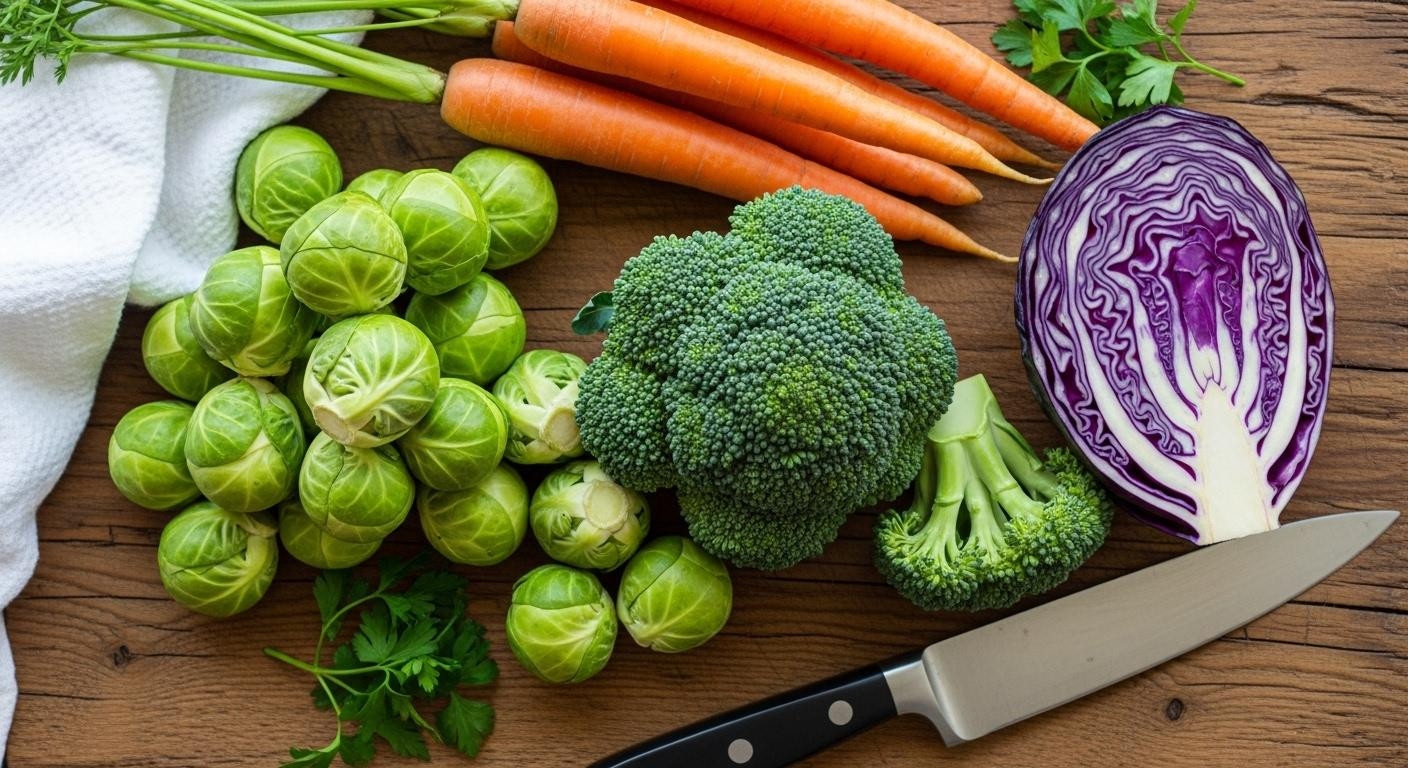If you’re among the 98 million Americans with prediabetes checking your glucose monitor after breakfast, watching numbers spike despite careful eating, you’re not alone. The frustration of unpredictable blood sugar responses haunts millions daily. Here’s what nutritionists know: 10 common winter vegetables most people walk past at the grocery store contain fiber compounds that flatten glucose curves by up to 30%. These aren’t exotic superfoods. They’re sitting in your produce aisle right now.
Why your blood sugar spikes while others stay stable after the same meal
The secret lies in fiber mechanisms most people don’t understand. It’s not just about carbs. It’s about specific fiber types that slow glucose release into your bloodstream. Research published in peer-reviewed journals demonstrates that high-fiber vegetables can reduce post-meal glucose spikes by 30% in people with type 2 diabetes.
Recent clinical trials reveal something remarkable. Cruciferous vegetables outperform root vegetables for blood sugar control. A groundbreaking 2025 study showed that people consuming cruciferous vegetable soups experienced 2% lower glycemic variability compared to those eating root vegetables. The difference? Sulforaphane compounds that specifically target your liver’s glucose production.
According to specialists in metabolic health, these 10 vegetables contain precise fiber profiles. Soluble and insoluble combinations create sustained glucose stability that diabetes medications struggle to match.
The 10 winter vegetables that flatten your glucose curve and why they work
Clinical evidence from multiple 2025 studies confirms these vegetables’ remarkable effects. Not all winter vegetables are created equal for blood sugar management.
Cruciferous powerhouses: Brussels sprouts, broccoli, cabbage
These contain sulforaphane, a compound that inhibits your liver’s overproduction of glucose. Research shows sulforaphane reduced fasting blood glucose by 0.2 millimoles per liter in 12-week trials. Brussels sprouts pack 3.3 grams of fiber per 8-sprout serving.
Broccoli delivers the highest sulforaphane concentrations when lightly steamed. Overcooking destroys myrosinase, the enzyme needed for sulforaphane conversion. One cup provides 2.4 grams of blood sugar-stabilizing fiber.
Cabbage offers glucosinolates that activate cellular pathways reducing inflammation and improving insulin sensitivity. Traditional fermentation as sauerkraut enhances these bioactive compounds even further.
Smart root vegetables: sweet potatoes, carrots, beets
Sweet potatoes have a glycemic index of 44-60 compared to white potatoes at 70-85. One medium sweet potato provides 3.8 grams of fiber that slows glucose absorption significantly.
Carrots surprise many with their low glycemic index of 39. Beta-carotene content improves insulin sensitivity through antioxidant effects. One cup sliced delivers 3.6 grams of protective fiber.
Beets contain 250 milligrams of nitrates per 100 grams. These compounds improve blood flow and glucose delivery to tissues. Nitrates reduce diabetes risk and improve outcomes for existing patients.
Leafy greens: spinach, kale, collard greens
Spinach provides 79 milligrams of magnesium per cooked cup. Magnesium serves as a cofactor for enzymes involved in glucose metabolism. Plant-based diets rich in leafy greens reduce diabetes risk by 25%.
Kale combines glucosinolates with high nitrate content. This dual action improves vascular function while supporting healthy glucose delivery. Massage with lemon juice to break down tough fibers and enhance absorption.
Collard greens offer 5 grams of fiber per cooked cup, the highest among leafy vegetables. Traditional Southern preparation without excess fat preserves maximum blood sugar benefits.
How to use these vegetables for maximum blood sugar control
Timing matters more than most realize. Eating vegetables before carbohydrates can reduce post-meal glucose spikes by up to 30%. This pre-coating effect slows carbohydrate absorption significantly.
The fiber-first meal strategy
Consume 2-3 cups of these vegetables before or with your main carbohydrate sources. Clinical trials show measurable improvements within 8-12 weeks of consistent intake. This strategy costs less than diabetes medication copays.
Research demonstrates that inflammation and blood sugar are interconnected. The same vegetables addressing glucose also reduce inflammatory markers by 34%.
Portion precision that works
Optimal daily intake includes 2 cups leafy greens, 1 cup cruciferous vegetables, and half a cup root vegetables per meal. Current market prices range from $1.50-$3.50 per pound, making this approach highly affordable.
Frozen vegetables retain 90-95% of nutrient content while costing 15-25% less than fresh. They offer identical fiber benefits with significant cost savings.
The preparation method most people get wrong
Overcooking vegetables increases their glycemic index while destroying heat-sensitive compounds. Steaming and light roasting at 400°F preserve fiber structure and nutrient content optimally.
Counter-intuitively, cooling cooked vegetables increases resistant starch content. Sweet potatoes become even more blood sugar-friendly when cooled after cooking. This simple step enhances their glucose-stabilizing effects.
Raw consumption maximizes fiber benefits for carrots and cabbage. Pairing with healthy fats moderates glycemic response while improving nutrient absorption significantly.
Your questions about blood sugar-stabilizing vegetables answered
Can I eat these vegetables if I’m on diabetes medication?
These are whole foods, not supplements, making them generally safe with medications. However, monitor blood glucose closely when increasing vegetable intake. Consult your healthcare provider before adjusting medication dosages based on improved readings.
How long before I see results in my glucose readings?
Clinical trials show most participants experienced 10-15% improvements within 8-12 weeks of consuming 3-plus servings daily. Track measurements before and 2 hours after meals for accurate assessment of progress.
Do organic vegetables work better than conventional for blood sugar control?
Fiber content remains identical between organic and conventional varieties. Organic costs 30-50% more but provides no additional glycemic benefits. Choose based on budget, not diabetes outcomes.
November morning frost touches Brussels sprouts at the farmers market. The elderly vendor arranges purple cabbage, knowing these same vegetables kept her grandmother’s blood sugar stable through Depression winters. Your cart waits. Your glucose curve depends on this choice.
